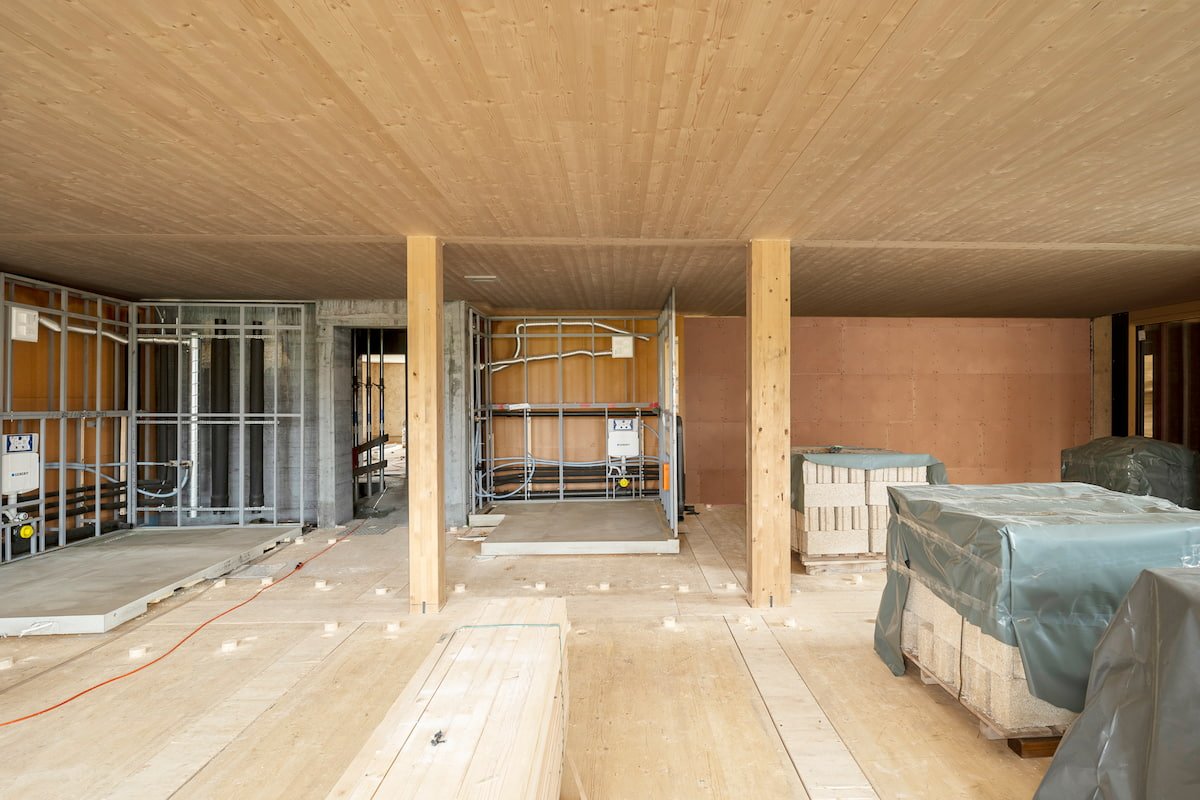Fact sheet wood
Key Facts KVH A1-3 installed in structure for 100 years
CO₂- Capturing: 727 kg/m³
Specific gravity: 470-500 kg/m³
Fire protection class: B2 according to EN 13501-1; DIN 4102
Thermal conductivity: 0. 13 W/m.ºK
Key Facts KVH D installed for 1-30 years, incl. recycling
CO₂- Capturing: 283.1 kg/m³
Specific gravity: 470-500 kg/m³
Fire protection class: B2 according to EN 13501-1; DIN 4102
Thermal conductivity: 0. 13 W/m.ºK
-
1 m³ of solid structural timber causes 80 kg of CO₂ during production, while approx. 300 kg of CO₂ are emitted for the production of 1 m³ of reinforced concrete.
Replaces building materials with negative ecological impacts - Life cycle assessment improvement
Supports regional sustainable development at the economic and societal level - adding value and securing jobs domestically.
low dead weight - high load capacity
regulates indoor climate and room temperature - contributes to healthy living
Wood insulates about 20 times better than concrete - 6.5 cm of softwood is as effective for insulation as 40 cm of solid brick
-
#biogenic: stomata on the surface of leaves and needles absorb CO₂ and trees build sugar from it.
These carbohydrates serve on the one hand as a source of energy, and on the other hand as a building material from which trees produce wood, bark, roots, leaves and needles. -> 6 H₂O + 6 CO₂ = 6 O₂ + C₆H₁₂O₆ (Glucose)
As long as a tree lives and grows, it absorbs more CO₂ than it releases through cell respiration. Only when the tree dies and is decomposed by microorganisms does it return the stored carbon to the air.
If the wood is installed, the absorbed CO₂ remains stored for long periods of time.
-
After harvesting, softwood is processed into raw logs on state-of-the-art chipping and circular sawing equipment and then dried in fully automatic, computer-controlled drying kilns.
The resulting sawmill by-products, such as bark, chips, and shavings, are used without residue to generate energy, produce paper, or manufacture wood-based materials.
-
1 m³ wood weighs 493 kg, of which 45 % is bound atmospheric carbon -> 1 m³ wood contains 220 kg C
During photosynthesis, 3.6664 kg CO₂ = 1 kg C is bound in the wood. 220 kg carbon (1 m³ wood) binds 807 kg CO₂.
Growth of 1 m³ of wood removes 807 kg CO₂ from the atmosphere (without processing/transport etc.)
The provision of raw materials, transport and production of 1 m³ of KVH emits 80.07 kg of CO₂, mainly due to the use of fossil fuels.
- 727 kg CO₂ manufacturing emissions Module A1-3
Raw material provision A1: - 768.7 kg CO₂
Transport A2: 9.52 kg CO₂
Production A3: 32.25 kg CO₂
-
Wood grows without producing additional energy and pollutants. On the contrary, trees provide oxygen and clean the air.
Wood is available nearby. Thanks to short transport routes, additional CO₂ emissions are avoided.
The Swiss forest has the highest supply of living trees in all of Central Europe.
Every year, 10 million m³ of wood grows in Switzerland.
Without overexploiting the forest, 7 to 8 million m³ of wood could be harvested annually. Used over longer periods of time, atmospheric carbon is thus naturally sequestered.
-
The CO₂ release at the end of the life cycle is shown in Module D Recycling Potential according to German ÖKOBAUDAT. There is a credit through e.g. combustion in a CHP plant and thus substitution of electricity & heat from fossil sources.
Module D is not applied in the Swiss KBOB, therefore the overall CO₂ balance of KBOB is worse than in ÖKOBAUDAT.
-
CO₂ calculation according to ÖKOBAUDAT current version 2021-II from 25.06.2021 according to EN15804+A2
Association of Swiss Forest Owners e.V.
FOEN (2007) 'CO₂ effects of the Swiss forestry and timber industry'.





